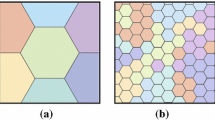Abstract
Existing methods for flower classification are usually focused on segmentation of the foreground, followed by extraction of features. After extracting the features from the foreground, global pooling is performed for final classification. Although this pipeline can be applied to many recognition tasks, however, these approaches have not explored structural cues of the flowers due to the large variation in their appearances. In this paper, we argue that structural cues are essential for flower recognition. We present a novel approach that explores structural cues to extract features. The proposed method encodes the structure of flowers into the final feature vectors for classification by operating on salient regions, which is robust to appearance variations. In our framework, we first segment the flower accurately by refining the existing segmentation method, and then we generate local features using our approach. We combine our local feature with global-pooled features for classification. Evaluations on the Oxford Flower dataset shows that by introducing the structural cues and locally pooling of some off-the-shelf features, our method outperforms the state-of-the-arts which employ specific designed features and metric learning.






Similar content being viewed by others
References
Akata Z, Reed S, Walter D, Lee H, Schiele B (2015) Evaluation of output embeddings for fine-grained image classification. In: 2015 IEEE conference on computer vision and pattern recognition (CVPR). IEEE, pp 2927–2936
Angelova A, Zhu S (2013) Efficient object detection and segmentation for fine-grained recognition. In: 2013 IEEE conference on computer vision and pattern recognition (CVPR). IEEE, pp 811–818
Angelova A, Zhu S, Lin Y (2013) Image segmentation for large-scale subcategory flower recognition. In: 2013 IEEE workshop on applications of computer vision (WACV). IEEE, pp 39–45
Angelova A, Zhu S, Lin Y, Wong J, Shpecht C (2012) Development and deployment of a large-scale flower recognition mobile app. NEC Labs America Technical Report
Boykov YY, Jolly MP (2001) Interactive graph cuts for optimal boundary & region segmentation of objects in nd images. In: 2001 IEEE international conference on computer vision (ICCV). IEEE, pp 105–112
Branson S, Van Horn G, Wah C, Perona P, Belongie S (2014) The ignorant led by the blind: a hybrid human–machine vision system for fine-grained categorization. Int J Comput Vis 108(1–2):3–29
Britto Mottos A, Schmidt Feris R (2014) Fusing well-crafted feature descriptors for efficient fine-grained classification. In: 2014 IEEE international conference on image processing (ICIP). IEEE, pp 5197–5201
Chai Y, Lempitsky V, Zisserman A (2011) Bicos: a bi-level co-segmentation method for image classification. In: 2011 IEEE international conference on computer vision (ICCV). IEEE, pp 2579–2586
Cheng M, Mitra NJ, Huang X, Torr PH, Hu S (2015) Global contrast based salient region detection. IEEE Trans Pattern Anal Mach Intell 37(3):569–582
Guru D, Kumar YS, Manjunath S (2011) Textural features in flower classification. Math Comput Model 54(3):1030–1036
Guru D, Sharath Y, Manjunath S (2010) Texture features and knn in classification of flower images. IJCA Special Issue on RTIPPR (1), pp 21–29
Kanan C, Cottrell G (2010) Robust classification of objects, faces, and flowers using natural image statistics. In: 2010 IEEE conference on computer vision and pattern recognition (CVPR). IEEE, pp 2472–2479
Khan FS, Weijer J, Bagdanov AD, Vanrell M (2011) Portmanteau vocabularies for multi-cue image representation. In: Advances in neural information processing systems, pp 1323–1331
Krause J, Jin H, Yang J, Fei-Fei L (2015) Fine-grained recognition without part annotations. In: 2015 IEEE conference on computer vision and pattern recognition (CVPR). IEEE, pp 5546–5555
Lin TY, RoyChowdhury A, Maji S (2015) Bilinear cnn models for fine-grained visual recognition. In: 2015 IEEE international conference on computer vision (ICCV). IEEE, pp 1449–1457
Lu Y, Zhang W, Jin C, Xue X (2012) Learning attention map from images. In: 2012 IEEE conference on computer vision and pattern recognition (CVPR). IEEE, pp 1067–1074
Mancas M, Mancas-Thillou C, Gosselin B, Macq B (2006) A rarity-based visual attention map-application to texture description. In: 2006 IEEE international conference on image processing (ICIP). IEEE, pp 445–448
Nilsback ME, Zisserman A (2007) Delving into the whorl of flower segmentation. BMVC, pp 1–10
Nilsback ME, Zisserman A (2008) Automated flower classification over a large number of classes. In: Sixth Indian conference on computer vision, graphics & image processing, 2008. ICVGIP’08. IEEE, pp 722–729
Nilsback ME, Zisserman A (2009) An automatic visual flora-segmentation and classification of flower images. Oxford University
Parkhi OM, Vedaldi A, Jawahar C, Zisserman A (2011) The truth about cats and dogs. In: 2011 IEEE International Conference on Computer Vision (ICCV). IEEE, pp 1427–1434
Parkhi OM, Vedaldi A, Zisserman A, Jawahar C (2012) Cats and dogs. In: 2012 IEEE conference on computer vision and pattern recognition (CVPR). IEEE, pp 3498–3505
Rosch E, Mervis CB, Gray WD, Johnson DM, Boyes-Braem P (1976) Basic objects in natural categories. Cogn Psychol 8(3):382–439
Vedaldi A, Zisserman A (2012) Efficient additive kernels via explicit feature maps. IEEE Trans Pattern Anal Mach Intell 34(3):480–492
Wah C, Maji S, Belongie S (2015) Learning localized perceptual similarity metrics for interactive categorization. In: 2015 IEEE winter conference on applications of computer vision (WACV). IEEE, pp 502–509
Wang J, Yang J, Yu K, Lv F, Huang T, Gong Y (2010) Locality-constrained linear coding for image classification. In: 2010 IEEE conference on computer vision and pattern recognition (CVPR). IEEE, pp 3360–3367
Zhang N, Donahue J, Girshick R, Darrell T (2014) Part-based r-cnns for fine-grained category detection. In: European conference on computer vision (ECCV). Springer, pp 834–849
Author information
Authors and Affiliations
Corresponding author
Rights and permissions
About this article
Cite this article
Pang, C., Yao, H., Sun, X. et al. Rediscover flowers structurally. Multimed Tools Appl 77, 7851–7863 (2018). https://doi.org/10.1007/s11042-017-4679-9
Received:
Revised:
Accepted:
Published:
Issue Date:
DOI: https://doi.org/10.1007/s11042-017-4679-9




